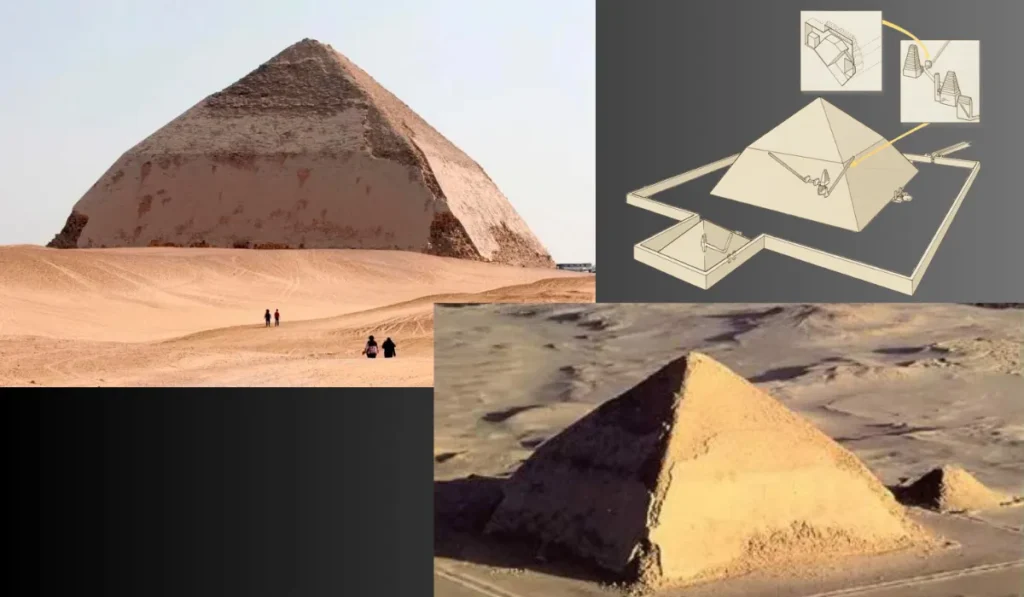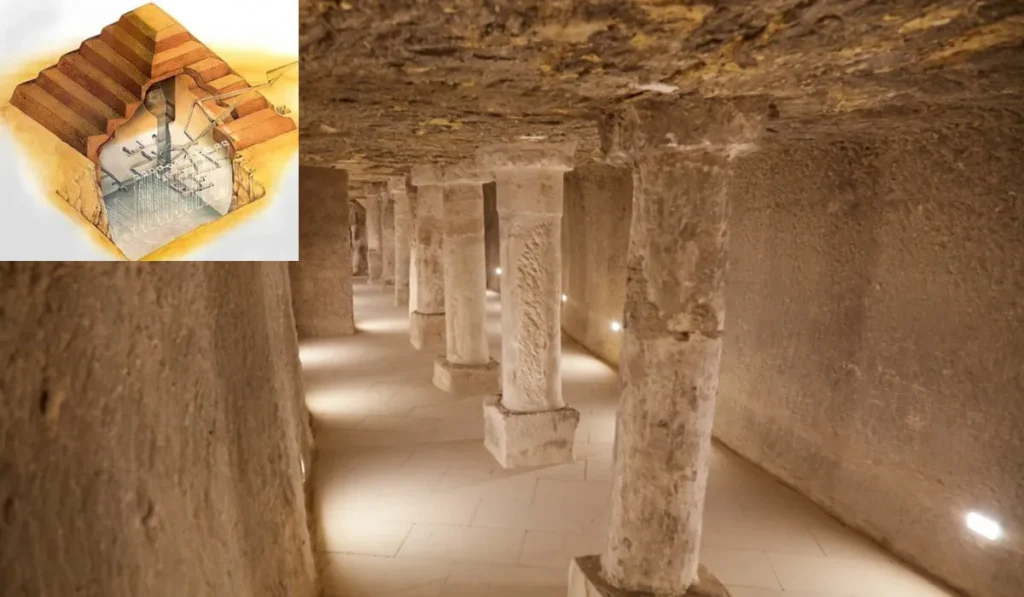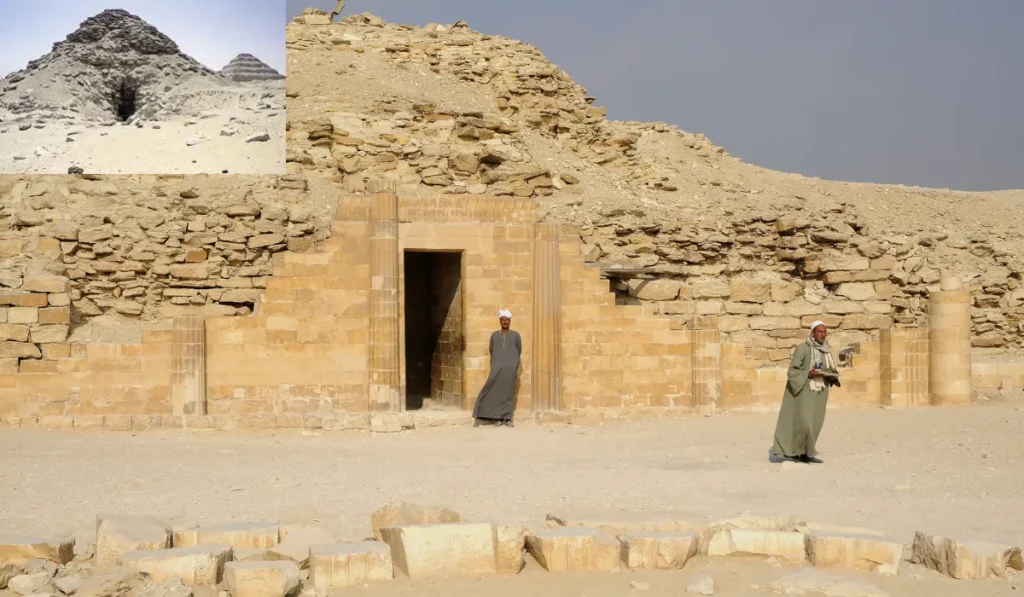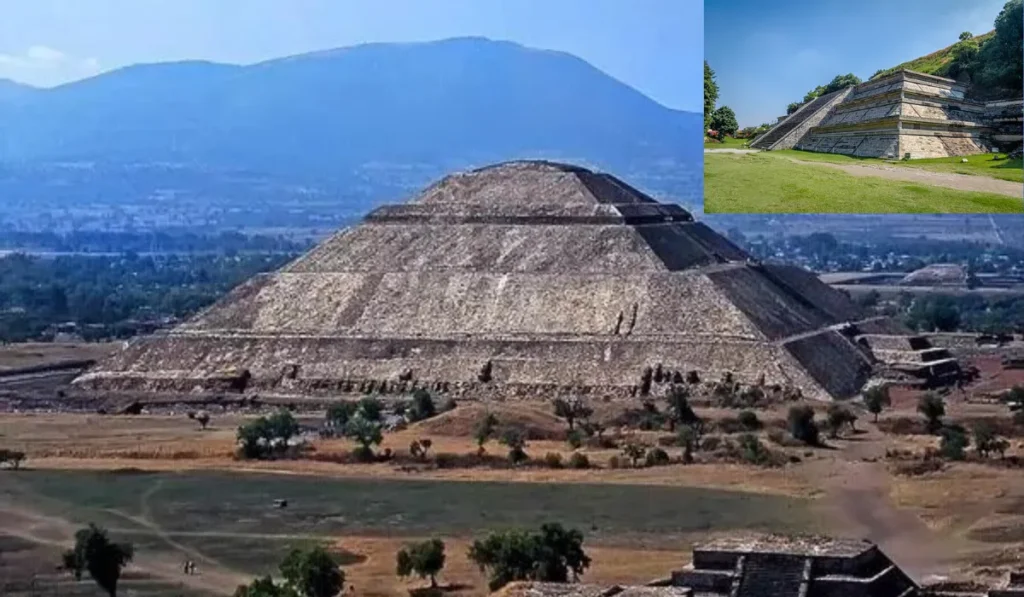Welcome to another exciting blog post where we delve into the fascinating world of ancient Egypt. Today, we will explore an intriguing question that might have crossed the mind of many archaeologists and enthusiasts: Do any Egyptian pyramids have 3 sides ? Join us as we journey through time and unravel the mystery surrounding the shape of Egyptian pyramids.
Introduction
Egyptian pyramids have always captured our imagination, serving as iconic symbols of one of the greatest civilizations in history. These monumental structures, built centuries ago, continue to astound us with their remarkable engineering and cultural significance. While the pyramids may seem like they all share the same iconic triangular shape, there is an interesting twist to this familiar image that has sparked curiosity. So, let’s dive in and explore the truth behind the question of whether any Egyptian pyramids have 3 sides.
The presence of three-sided pyramids, however, is a fascinating issue in the study of ancient Egyptian architecture that has piqued curiosity in both scholarly circles and the general public.
We shall dig into the fascinating world of the mysterious Egyptian three-sided pyramids.

Do any Egyptian pyramids have 3 sides ?
Contrary to common opinion, the Egyptian pyramids, which are famous for their four-sided architecture, rarely have only three sides. The majority of the pyramids built in ancient Egypt adhere to the standard design, which has four triangular faces that come together at a single apex. However, there are unique instances where the conventional shape is deviated, resulting in the creation of pyramids that display an intriguing triangular profile or 3 sided pyramid.
What does a 3 sided pyramid mean?
A three-sided pyramid in Egypt represents an exceptional departure from the norm, pushing the boundaries of architectural design. Such pyramids often possess a symbolic significance, representing a departure from conventional religious or historical themes present in the more widespread pyramids. The presence of a three-sided pyramid should be seen as an artistic statement, provoking deep thought and exploring new possibilities within the rich tapestry of Egyptian history.
Are the Egyptian pyramids 3 or 4 sided?
The overwhelming majority of Egyptian pyramids boast the traditional four-sided structure. This characteristic shape has become emblematic of ancient Egypt, symbolizing the divine connection between the earthly and celestial realms. The four-sided design brings harmony and balance, embodying the holistic worldview of the ancient Egyptians. However, the rare instances of three-sided pyramids add an intriguing element to the architectural landscape.
Where are three-sided pyramids?
The Pyramid of Djoser, which is situated in Saqqara, is the most well-known example of a three-sided pyramid in Egypt.
Dating back to the 27th century BCE, this ancient marvel stands as a testament to the ingenuity of early pyramid builders. While it has uncommon features, such as six stacked mastabas, this pyramid ultimately embodies a three-sided shape, captivating all who gaze upon it.

What’s inside the 3 Sided Step Pyramid of Djoser?
The Step Pyramid of Djoser is a remarkable architectural masterpiece that stands as a testament to the ingenuity and grandeur of ancient Egypt. This complex structure, located in Saqqara, near Cairo, is one of the earliest colossal stone buildings in history. Its construction marked a significant milestone in the evolution of pyramid design and set the stage for the majestic pyramids that followed.
1. The Burial Chamber: A Journey into the Depths
The main burial chamber is located in the centre of Djoser’s Step Pyramid. This chamber was the tomb of King Djoser, the pharaoh for whom the pyramid was constructed. It was located at the bottom of a shaft that extended 90 feet (28 metres) below.
Evidence of the craftsmanship of ancient Egyptian craftspeople may be seen in the burial chamber, which was cut out of solid rock and coated with granite. A stunning display of colour and beauty is produced by the blue faience tiles that adorn its walls.
Unfortunately, the priceless items that formerly travelled with the pharaoh to the afterlife have vanished due to the room’s theft in antiquity.
2. The Queen’s Chamber: A Royal Abode
To the east of the burial chamber, we find the Queen’s Chamber. This chamber is believed to have been the final resting place of Queen Hetephernebty, King Djoser’s consort.
Though smaller in size compared to the main burial chamber, the Queen’s Chamber exhibits exquisite reliefs depicting the king and queen, providing insights into the royal life of ancient Egypt.
3. The Subterranean Chambers: Mysteries Beneath the Surface
Beneath the Step Pyramid, a network of subterranean chambers awaits discovery. These enigmatic chambers, concealed beneath the pyramid’s foundation, have long fascinated archaeologists and historians.
While their exact purpose remains a subject of speculation, it is widely believed that these chambers served ritualistic functions, possibly related to the pharaoh’s journey to the afterlife. Exploring these subterranean chambers promises to unveil secrets that have remained hidden for millennia.
4. The Mortuary Temple: Gateway to the Divine
To the north of the Step Pyramid stands the Mortuary Temple. This majestic structure served as a place of religious ceremonies and rituals dedicated to the memory of King Djoser. Surrounded by a colonnade, the Mortuary Temple was an architectural marvel of its time, featuring ornate decorations and intricate reliefs that glorified the pharaoh’s reign and celebrated his divine status.
5. The Serdab: A Silent Guardian
Nestled within the courtyard of the Mortuary Temple is a small enclosed structure known as the Serdab. This humble chamber housed the ka statue of King Djoser, a representation of his eternal spirit. The Serdab served as a place for the pharaoh’s soul to reside and receive offerings, ensuring his immortality in the afterlife.
The Step Pyramid of Djoser is a magnificent archaeological site that never fails to astound visitors and experts alike with its intricate construction and numerous rooms. Despite the fact that the pyramid is still shrouded in mystery in many ways, its significance cannot be emphasised. The Step Pyramid, a UNESCO World Heritage Site, has great historical and cultural significance and offers unique insights into ancient Egyptian culture.
READ MORE – 1 week or Months | How Long Is Dig Season In Egypt – Know Details
Why are there 3 great pyramids?
The three massive Egyptian pyramids, which are significant both historically and culturally, are located on the Giza Plateau.
For Khufu, Khafre, and Menkaure, three Egyptian pharaohs, they were built as beautiful burial tombs.
These enormous structures serve as permanent resting places for the pharaohs’ spirits to ascend to join the gods as a testament to their power and grandeur.

Were all 3 pyramids built at the same time?
Contrary to common belief, none of the three major pyramids were constructed simultaneously.
Between 2580 and 2560 BCE, the Great Pyramid of Khufu, the oldest and greatest of the three pyramids, was built in a breathtaking feat of organisation and engineering.
The second pyramid, which was constructed between 2570 and 2544 BCE, is attributed to Khafre. The smallest of the three was finished between 2510 and 2460 BCE and was devoted to Menkaure.
What’s inside the 3 pyramids?
Exploring the inner chambers of these ancient pyramids reveals fascinating insights into the beliefs and rituals of ancient Egyptians. Each pyramid contains various chambers, passageways, and chambers, which served specific purposes. The most well-known feature is the burial chambers, where the pharaohs were interred alongside precious treasures and valuable possessions meant to accompany them into the afterlife. Additionally, there are other chambers that served religious and ceremonial functions.
What are the 3 main pyramids called?
On the Giza Plateau, there are three primary pyramids, each with a unique set of characteristics. The Great Pyramid of Khufu, commonly known as the Pyramid of Cheops, is the biggest and most well-known of the triplets. Next to it is the Pyramid of Khafre, which still bears the name of the king who oversaw construction. The Pyramid of Menkaure, the smallest of the three pyramids, was constructed in memory of the same-named king.
Is there a 5 sided pyramid?
In the realm of Egyptian pyramids, five-sided structures are an extreme rarity. The majority of pyramids adhere to a four-sided design, promoting stability and balance. Nonetheless, there is an intriguing exception known as the Bent Pyramid, situated in Dahshur. This unique structure possesses a distinct 55-degree slope, deviating from the conventional four-sided shape and providing an extraordinary example of experimental architecture.

Which pyramids to go inside?
Visitors to Egypt have the chance to explore the interiors of various pyramids, while entrance to some interiors may be restricted for preservation or current archaeological excavation. Visitors may see the wonders of ancient engineering at the Great Pyramid of Khufu, which offers a remarkable trip into the core of ancient Egyptian building. Another amazing alternative to check out that sheds light on the period’s religious practises is the Pyramid of Khafre.

What is the most beautiful pyramid in Egypt?
Egypt’s pyramids encompass a beauty that transcends time, but one pyramid, in particular, captivates many with its serene and harmonious design. The Pyramid of Senusret III, situated in Dahshur, charms visitors with its elegant structure and towering presence. Its unique shape, characterized by smooth walls and an aura of tranquility, truly sets it apart as one of Egypt’s most captivating architectural creations.
What is Egypt’s most famous pyramid?
When it comes to fame and notoriety, the Great Pyramid of Giza, also known as the Pyramid of Khufu, is difficult to ignore.
The last remaining wonder of the ancient world, this renowned building is a massive testament to the pharaoh’s quest for immortality. It is the jewel in the crown of Egypt’s extensive cultural heritage because of its immense size, complex design, and enigmatic presence.
What is the oldest pyramid in Egypt?
The honor of being the oldest pyramid in Egypt falls upon the remarkable Pyramid of Djoser, built during the 27th century BCE. This architectural masterpiece, designed by the renowned Imhotep, boasts an iconic step pyramid structure that served as an awe-inspiring testament to the divine power of the ancient pharaohs. Its age and remarkable preservation make it an invaluable treasure of Egypt’s ancient past.

What is the greatest pyramid ever built?
The title of biggest pyramid ever built belongs without a doubt to the Great Pyramid of Giza.
It stands out as an unrivalled tribute to human aspiration, inventiveness, and dedication to the divine due to its enormous size, flawless craftsmanship, and the engineering wonders necessary to build it. The greatness of the pharaoh Khufu and the culture that gave rise to it are immortally attested to by this pyramid.
Which pyramid is worth visiting?
Fans of ancient Egyptian history should without a doubt see the Pyramid of Khafre, also known as the Second Pyramid of Giza, even if each pyramid in Egypt is fascinating and significant in its own right.
Visitors may fully immerse themselves in the grandeur and spirituality that characterised the life of pharaohs and their subjects thanks to its stunning presence and a rather well-preserved inner complex.
What is the biggest hidden pyramid?
Deep within the excavation site of Saqqara lies a hidden gem waiting to be fully unveiled – the Pyramid of Userkaf. This pyramid, dedicated to pharaoh Userkaf, is the largest among a group of lesser-known pyramids in the area. While its full glory has yet to be completely revealed, the ongoing archaeological efforts offer glimpses into the majestic scale and potential mysteries that lie within its ancient walls.

Who is buried under the biggest pyramid?
The massive scale of the Great Pyramid of Khufu leads many to wonder who lies within its towering structure. Although there is no conclusive evidence, it is widely believed that Pharaoh Khufu himself, the second ruler of the Fourth Dynasty, is buried within this colossal monument. The grandeur and complexity of the pyramid’s construction align with the prestige and power of one of Egypt’s most renowned pharaohs.
READ MORE – How Long Do Archaeological Digs Last : Everything from Start to finish
Is there a secret room in the pyramid?
People have always been attracted by the idea of hidden chambers within the pyramids and have speculated about this idea.
While no direct evidence of a secret room has been unequivocally proven, ongoing research and advancements in technology continue to uncover new possibilities. The tantalising idea of hidden rooms and their mysteries becomes more alluring than ever with the finding of previously unidentified gaps within the Great Pyramid of Giza.
What is the least famous pyramid?
Among the myriad pyramids scattered across Egypt, some have sadly faded into the lesser-known corners of history. One such pyramid is the Pyramid of Amenemhat III, situated in Dahshur. While it may not enjoy the fame of its counterparts, this pyramid offers a unique glimpse into the evolution of pyramid construction, showcasing an early attempt to create a smooth-sided structure – a precursor to the refined architectural wonders that followed.

Where is the largest pyramid on Earth?
The Great Pyramid of Cholula in Mexico holds the record for being the biggest pyramid on Earth.This gigantic structure is 450 metres long on each side and dwarfs even the most exquisite Egyptian pyramids. It was initially constructed as a temple to commemorate the deity Quetzalcoatl. It is an incredibly impressive example of ancient engineering due to its size and historical relevance.

Conclusion
I hope you got the answer for this question ” Do any Egyptian pyramids have 3 sides ?”
Egyptian pyramids, whether three or four-sided, continue to captivate our imagination. The Step Pyramid of Djoser is a remarkable example of the sophisticated engineering and architectural abilities of ancient Egypt, to sum up.
From the intrigue of hidden chambers to the timeless beauty of iconic structures, each pyramid carries a unique story and offers a glimpse into the splendor of ancient civilizations. We are reminded of the impressive accomplishments of humanity as we uncover their mysteries and the enduring impact of the pharaohs.
FAQs
Can visitors enter the burial chamber of the Step Pyramid of Djoser?
No, the burial chamber is not accessible to visitors. However, there are other chambers and tunnels within the pyramid that can be explored.
Are there any artifacts on display at the Step Pyramid of Djoser?
Most of the artifacts that were originally housed in the pyramid’s chambers have been relocated to museums. However, some replicas and artifacts discovered during excavations can be seen in the nearby Saqqara Museum.
How long did it take to build the Step Pyramid of Djoser?
The construction of the Step Pyramid spanned several years, with estimates ranging from 10 to 20 years. It was a complex undertaking that required meticulous planning and skilled labor.
Are there other pyramids in the vicinity of the Step Pyramid of Djoser?
Yes, the Saqqara necropolis is home to numerous pyramids and ancient tombs. It is a vast archaeological site that offers a wealth of historical and cultural treasures.
Is the Step Pyramid of Djoser open to the public?
Yes, the Saqqara necropolis is home to numerous pyramids and ancient tombs. It is a vast archaeological site that offers a wealth of historical and cultural treasures.
